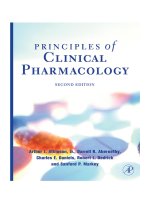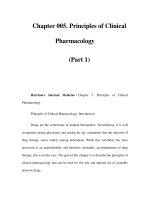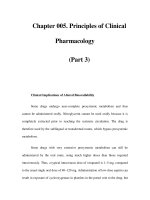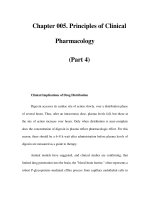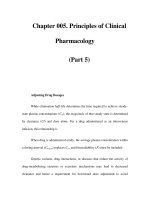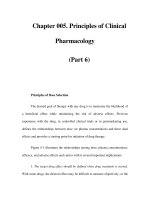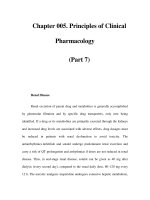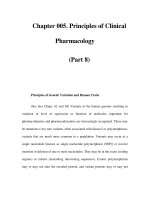Chapter 005. Principles of Clinical Pharmacology (Part 14) potx
Bạn đang xem bản rút gọn của tài liệu. Xem và tải ngay bản đầy đủ của tài liệu tại đây (25.44 KB, 6 trang )
Chapter 005. Principles of Clinical
Pharmacology
(Part 14)
Diagnosis and Treatment of Adverse Drug Reactions
The manifestations of drug-induced diseases frequently resemble those of
other diseases, and a given set of manifestations may be produced by different and
dissimilar drugs. Recognition of the role of a drug or drugs in an illness depends
on appreciation of the possible adverse reactions to drugs in any disease, on
identification of the temporal relationship between drug administration and
development of the illness, and on familiarity with the common manifestations of
the drugs. Many associations between particular drugs and specific reactions have
been described, but there is always a "first time" for a novel association, and any
drug should be suspected of causing an adverse effect if the clinical setting is
appropriate.
Illness related to a drug's intended pharmacologic action is often more
easily recognized than illness attributable to immune or other mechanisms. For
example, side effects such as cardiac arrhythmias in patients receiving digitalis,
hypoglycemia in patients given insulin, and bleeding in patients receiving
anticoagulants are more readily related to a specific drug than are symptoms such
as fever or rash, which may be caused by many drugs or by other factors.
Electronic sources of adverse drug reactions can be useful. However,
exhaustive compilations often provide little sense of perspective in terms of
frequency and seriousness, which can vary considerably among patients.
Eliciting a drug history from patients is important for diagnosis. Attention
must be directed to OTC drugs and herbal preparations as well as to prescription
drugs. Each type can be responsible for adverse drug effects, and adverse
interactions may occur between OTC drugs and prescribed drugs. Loss of efficacy
of oral contraceptives or cyclosporine by concurrent use of St. John's wort are
examples. In addition, it is common for patients to be cared for by several
physicians, and duplicative, additive, counteractive, or synergistic drug
combinations may therefore be administered if the physicians are not aware of the
patients' drug histories. Every physician should determine what drugs a patient has
been taking, for the previous month or two ideally, before prescribing any
medications. Medications stopped for inefficacy or adverse effects should be
documented to avoid pointless and potentially dangerous reexposure. A frequently
overlooked source of additional drug exposure is topical therapy; for example, a
patient complaining of bronchospasm may not mention that an ophthalmic beta
blocker is being used unless specifically asked. A history of previous adverse drug
effects in patients is common. Since these patients have shown a predisposition to
drug-induced illnesses, such a history should dictate added caution in prescribing
drugs.
Laboratory studies may include demonstration of serum antibody in some
persons with drug allergies involving cellular blood elements, as in
agranulocytosis, hemolytic anemia, and thrombocytopenia. For example, both
quinine and quinidine can produce platelet agglutination in vitro in the presence of
complement and the serum from a patient who has developed thrombocytopenia
following use of this drug. Biochemical abnormalities such as G6PD deficiency,
serum pseudocholinesterase level, or genotyping may also be useful in diagnosis,
often after an adverse effect has occurred in the patient or a family member.
Once an adverse reaction is suspected, discontinuation of the suspected
drug followed by disappearance of the reaction is presumptive evidence of a drug-
induced illness. Confirming evidence may be sought by cautiously reintroducing
the drug and seeing if the reaction reappears. However, that should be done only if
confirmation would be useful in the future management of the patient and if the
attempt would not entail undue risk. With concentration-dependent adverse
reactions, lowering the dosage may cause the reaction to disappear, and raising it
may cause the reaction to reappear. When the reaction is thought to be allergic,
however, readministration of the drug may be hazardous, since anaphylaxis may
develop. Readministration is unwise under these conditions unless no alternative
drugs are available and treatment is necessary.
If the patient is receiving many drugs when an adverse reaction is
suspected, the drugs likeliest to be responsible can usually be identified; this
should include both potential culprit agents as well as drugs that alter their
elimination. All drugs may be discontinued at once or, if this is not practical,
discontinued one at a time, starting with the ones most suspect, and the patient
observed for signs of improvement. The time needed for a concentration-
dependent adverse effect to disappear depends on the time required for the
concentration to fall below the range associated with the adverse effect; that, in
turn, depends on the initial blood level and on the rate of elimination or
metabolism of the drug. Adverse effects of drugs with long half-lives or those not
directly related to serum concentration may take a considerable time to disappear.
Summary
Modern clinical pharmacology aims to replace empiricism in the use of
drugs with therapy based on in-depth understanding of factors that determine an
individual's response to drug treatment. Molecular pharmacology,
pharmacokinetics, genetics, clinical trials, and the educated prescriber all
contribute to this process. No drug response should ever be termed idiosyncratic;
all responses have a mechanism whose understanding will help guide further
therapy with that drug or successors. This rapidly expanding understanding of
variability in drug actions makes the process of prescribing drugs increasingly
daunting for the practitioner. However, fundamental principles should guide this
process:
The benefits of drug therapy, however defined, should always
outweigh the risk.
The smallest dosage necessary to produce the desired effect
should be used.
The number of medications and doses per day should be
minimized.
Although the literature is rapidly expanding, accessing it is
becoming easier; tools such as computers and hand-held devices to search
databases of literature and unbiased opinion will become increasingly
commonplace.
Genetics play a role in determining variability in drug
response and may become a part of clinical practice.
Prescribers should be particularly wary when adding or
stopping specific drugs that are especially liable to provoke interactions and
adverse reactions.
Prescribers should use only a limited number of drugs, with which they are
thoroughly familiar.
